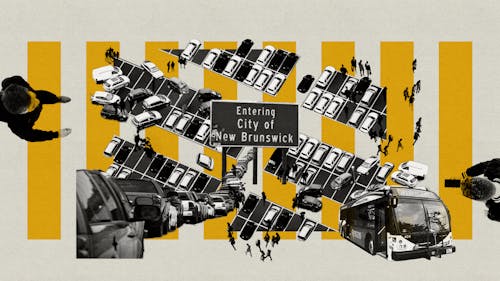EDITORIAL: Traffic jams in New Brunswick turn streets into parking lots

It is an uncontested fact that one of the most notorious complaints of Rutgers students is the bus system. It is easy to blame this issue on the buses themselves, but, in actuality, these transportation challenges are a symptom of a larger logistical problem that requires comprehensive solutions from the University and the city: overcapacity.
The recent estimates from the US Census Bureau, showing approximately 56,000 people residing in New Brunswick in 2022, clearly indicate the magnitude of the issue. In the last half-century, New Brunswick's population has surged by a staggering 40 percent. But while the population may have expanded exponentially, the city's limits have not.
This glaring oversight in urban planning has left Rutgers students and the surrounding communities grappling with a population density that is approximately 35 times greater than the national average for metropolitan areas.
As of 2016, street congestion and deficiency cost residents of New Jersey more than $2,600 annually, causing drivers to lose a staggering 261 million hours to congestion and travel time every single year — time that could be spent productively or with loved ones rather than squandered in traffic jams.
This issue is compounded by the University's seemingly relentless ambition to inflate its student body year after year, without a corresponding expansion in infrastructure or a viable plan to mitigate the inevitable urban congestion. Yet Rutgers continues to boast of the largest incoming freshman classes it has ever seen, with approximately 7,750 new students in the Fall 2022 semester. And with the current capacity of the city, rampant traffic makes traveling to and from classes extremely challenging for all.
The effects of the strain on local infrastructure are not just a minor inconvenience but an impediment to the city's functionality itself. There is an urgent need for strategic urban planning that goes hand in hand with the University's expansion policies.
Roadways are more clogged than ever, with an annual cost of $7.3 billion to the economy due to traffic jams in 2003, a figure that is sure to have risen since.
The dysfunction of the bus system at Rutgers is a glaring example. Students grapple with erratic schedules and insufficient routes, presenting not just inconvenience but a fundamental breakdown of a service that should be a cornerstone of University life.
As a symptom of this issue, many students are forced to resort to personal vehicles or bicycles, adding to the already severe traffic congestion. This not only exacerbates the problem but also raises serious concerns about the safety of pedestrians and cyclists navigating this chaos.
The relentless traffic congestion plaguing New Brunswick is not merely a logistical headache but a social and environmental disaster. As the University expands and the cityscape transforms, the threat of gentrification persists. This upheaval often displaces long-standing residents, eroding the cultural fabric and community bonds that have defined these neighborhoods for generations.
Moreover, congestion significantly contributes to the city's air pollution levels, of which vehicle emissions are the primary source. These air quality issues significantly impact public health. A particularly distressing aspect of this is the effect of this pollution on disadvantaged communities, which are often the hardest hit due to their proximity to high-traffic areas.
This begs the question: What are the roles and responsibilities of the University and city at large in mitigating traffic congestion, and can anything even be done?
Addressing this crisis requires varied approaches. Possible avenues for improvement lie in the University and the city's infrastructure. The establishment of bus-only lanes would not only alleviate road congestion but also make public transportation more reliable and appealing to students. This, in turn, could reduce the number of personal vehicles on the road and further reduce traffic.
Policy changes are also crucial. This includes stricter enforcement of traffic laws and significant improvements in pedestrian safety infrastructure. The promotion of bike-sharing or renting programs would also provide students with an affordable option for transportation, made even more enticing if roads are safer.
Even the Veo scooter program, launched as an alternative to bus riding in 2020 and seldom used by students for this purpose since its inception, might begin to see increased usage.
The University must play a proactive role in these initiatives, not just as a stakeholder but as a leader in advocating for and implementing change. Its influence and resources could be pivotal in driving these solutions forward.
The Daily Targum's editorials represent the views of the majority of the 155th editorial board. Columns, cartoons and letters do not necessarily reflect the views of the Targum Publishing Company or its staff.



